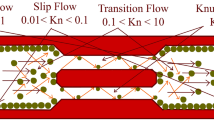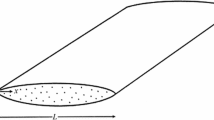Abstract
The hydraulic diffusivity and permeability of a rock mass can be measured with a double packer permeameter, placed in a long bore hole. If the flow is steady, the relation between supply pressure and flux is a measure of the permeability whereas if the flow is transient, the relation is a measure of both the hydraulic diffusivity of the rock and the elasticity of the equipment. If the equipment is effectively rigid and the distance between the packers is much bigger than the size of the packers, an approximate closed solution is characterized bytwo parameters: the distance between the packers divided by the radius of the hole and the width of the packers divided by the radius of the hole. The flow is fully 3-D if the hydraulic diffusion distance far exceeds the distance between the packers. If the elasticity of the equipment is not negligible, the transient solution is characterized byone parameter including the elasticity coefficient of the equipment the conductivity of the rock and the radius of the hole. The relations between pressure and flux is given as a closed formula, suitable for engineering practice.
Similar content being viewed by others
Abbreviations
- a ≈ 0.8905:
-
numerical constant
- B(r,ξ):
-
auxiliary function
- c(t):
-
dimensionless potential between the packers
- ċ(t):
-
dimensionless time derivative ofc(t)
- f(z):
-
auxiliary function
- F(τ):
-
auxiliary function
- g :
-
gravity acceleration
- G(τ):
-
auxiliary function
- K :
-
conductivity
- m :
-
auxiliary variable
- N(t):
-
integration limit
- p :
-
pore pressure
- p 0 :
-
reference pressure
- P(r, m, t):
-
auxiliary function
- Q′(t′),Q′ p(t′):
-
fluxes
- Q(t),Q p(t):
-
dimensionless fluxes
- Q st :
-
dimensionless stationary flux
- (r′, θ, z′):
-
cylindrical coordinates
- t :
-
dimensionless time
- z′ 0 :
-
distance between the packers
- z 0 :
-
dimensionless distance between the packers
- β :
-
dimensionless rise rate of the potential between the packers
- β 0 :
-
dimensionless second rise rate of the potential between the packers
- γ′ :
-
coefficient of elasticity
- γ :
-
dimensionless coefficient of elasticity
- Δ′ :
-
axial length of a packer
- Δ :
-
dimensionless axial length of a packer
- ξ(t):
-
integration limit
- θ :
-
dimensionless rise rate of the potential between the packers
- κ :
-
hydraulic diffusivity
- ϱ :
-
density of water
- (r,θ,z):
-
dimensionless cylindrical coordinates
- R(τ):
-
auxiliary function
- r 0 :
-
radius of the hole
- S 0 :
-
specific storativity
- s :
-
auxiliary variable
- t′ :
-
time
- τ :
-
dummy variable
- φ′(r′,θ,z′):
-
potential
- φ(r,θ,z):
-
dimensionless potential
- φ 0 :
-
reference potential
- φ∞ :
-
undisturbed potential
- ξ :
-
dummy variable
References
Lugeon, M.,Barrage et Geologie. Paris: Dunod (1933).
Moye, D.G., Diamond drilling for foundation exploration.Civ. Eng. Trans. CE9.1 (1967) 95–100.
Cooper, H.H., Bredehoeft, J.D. and Papadopulos, S.S., Response of a finite-diameter well to an instantaneous charge of water.Water Res. Res. 3 (1967) 263–269.
Carlsson, A. and Olsson, T., Hydraulic properties of crystalline rocks. Hydraulic conductivity and its relation to depth.Bull. Geol. Inst. Univ. of Uppsala 7 (1977).
Carlsson, A. and Olsson T., Water pressure tests for determining hydraulic conductivity.Bull. Geol. Inst. Univ. of Uppsala 8 (1979).
Bredehoeft, J.D. and Papadopulos, S.S., A method for determining the hydraulic properties of tight formations.Water Res. Res. 16 (1980) 233–238.
Neuzil, C.E., On conducting the modified ‘slug’ test in tight formations.Water Res. Res. 18 (1982) 439–441.
Dougherty, D.E. and Babu, D.K., Flow to a partially penetrating well in doubly-porosity reservoir.Water Res. Res. 20 (1980) 1116–1122.
Hayashi, K., Ito, T. and Abe, H., A new method for the determination of in situ hydraulic properties by pressure pulse tests and applications to the Higashi geothermal field.J. Geophys. Res. 92 (1984) 9168–9174.
Pickens, J.F., Grisak, G.E., Avis J.D. Belanger, D.W. and Thury, M., Analysis and interpretation of borehole hydraulic tests in deep boreholes: Principles, models, development and applications.Water Res. Res. 23 (1987) 1341–1375.
Barker, J.A., A generalized radial flow model for hydraulic tests in fractured rock.Water Res. Res. 24(10) (1988) 1796–1804.
Carslaw, H.S. and Jaeger, J.C.,Conduction of Heat in Solids. Oxford: Oxford University Press (1959).
Doetsch, G.,Tabellen zur Laplace-Transformation und Ableitung zum Gebrauch. Berlin: Springer-Verlag (1947).
Abramowitz, M. and Stegun, I.A.,Handbook of Mathematical Functions. New York: Dover (1970).
Gradshteyn, I.S. and Ryzhik, I.M.,Tables of Integrals, Series and Products. New York: Academic Press (1980).
Author information
Authors and Affiliations
Rights and permissions
About this article
Cite this article
Rehbinder, G. The double packer permeameter with narrow packers. Analytical solution for non steady flow. Appl. Sci. Res. 56, 255–279 (1996). https://doi.org/10.1007/BF02251034
Received:
Revised:
Issue Date:
DOI: https://doi.org/10.1007/BF02251034




